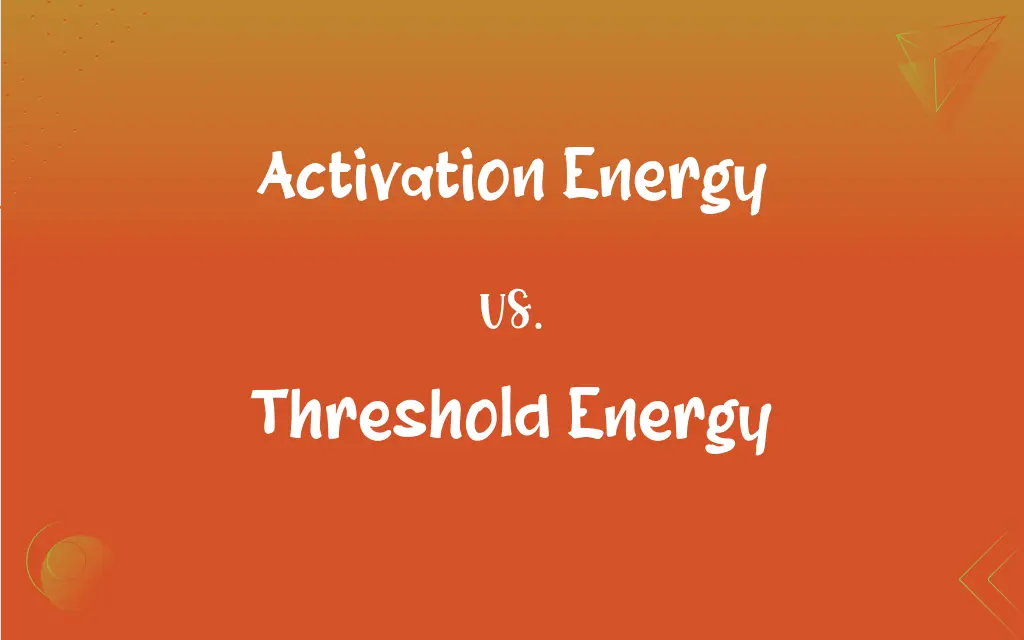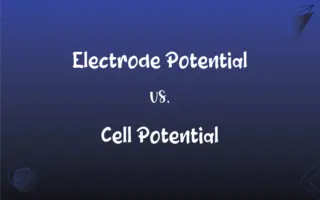Activation Energy vs. Threshold Energy: What's the Difference?
Edited by Aimie Carlson || By Janet White || Published on January 31, 2024
Activation energy is the minimum energy required for a reaction to occur, while threshold energy is the total energy needed to produce a reaction product.

Key Differences
Activation energy is the minimum energy necessary for reactants to undergo a chemical reaction, essentially acting as an energy barrier. Threshold energy, on the other hand, refers to the total energy that reactant molecules must possess to result in a successful product formation, incorporating both kinetic and potential energies.
Activation energy plays a crucial role in determining the rate of a chemical reaction; lower activation energy means faster reaction rates. In contrast, threshold energy is a concept that indicates the exact energy level needed for a reaction to yield products, considering all energy contributions.
The concept of activation energy is widely used in explaining the influence of catalysts, which lower this energy requirement, thereby accelerating reactions. Threshold energy, meanwhile, remains a fixed value for a given reaction, representing the comprehensive energy state necessary for product formation.
Activation energy is often graphically represented in energy profile diagrams, illustrating the energy barrier that reactants must overcome. Threshold energy, though related, is the sum of activation energy and the energy of reactants, defining the minimum energy state needed for the reaction’s completion.
In practical applications, activation energy helps in understanding chemical kinetics and designing reactions with desired speeds. Threshold energy, conversely, is used to determine the feasibility and the extent of reactions, as it encompasses all energy aspects, including the intrinsic energy of reactants.
ADVERTISEMENT
Comparison Chart
Definition
Minimum energy needed to initiate a reaction
Total energy required for reactants to form products
Role in Chemical Reactions
Determines reaction rate
Determines reaction feasibility
Influence of Catalysts
Decreased by catalysts
Unaffected by catalysts
Energy Profile Representation
Shown as a barrier in energy diagrams
Represented as a total energy value in diagrams
Practical Application
Used in predicting and controlling reaction rates
Used to assess reaction possibility and extent
ADVERTISEMENT
Activation Energy and Threshold Energy Definitions
Activation Energy
It is a crucial factor in determining the rate of a reaction.
Lowering the activation energy with a catalyst can accelerate chemical manufacturing processes.
Threshold Energy
It encompasses both kinetic and potential energies of reactants.
In a nuclear reaction, the threshold energy includes both the kinetic energy and binding energies of particles.
Activation Energy
Activation energy can be influenced by environmental factors like temperature.
Heating increases the kinetic energy of molecules, effectively lowering the activation energy for a reaction.
Threshold Energy
Threshold energy is the total energy needed for reactants to transform into products.
The threshold energy in a fireworks explosion dictates the intensity and color of the display.
Activation Energy
It's the energy barrier that reactants must overcome for a reaction to proceed.
Striking a match provides the activation energy to start the combustion process.
Threshold Energy
Threshold energy represents the energy state for a reaction to yield products.
The high threshold energy in nuclear fusion is why such reactions require extreme conditions.
Activation Energy
Activation energy is the minimal energy required to initiate a chemical reaction.
A spark provides the activation energy needed for gasoline to ignite in an engine.
Threshold Energy
Threshold energy determines whether a reaction is feasible.
If the reactants in a chemical experiment don't meet the threshold energy, no reaction will occur.
Activation Energy
Activation energy is the difference in energy between reactants and the transition state.
The activation energy in enzyme-catalyzed reactions is lowered, speeding up biological processes.
Threshold Energy
It's a fixed value for a specific reaction, unlike variable activation energy.
The threshold energy for a chemical reaction remains constant, regardless of the presence of a catalyst.
FAQs
Does threshold energy change with a catalyst?
No, threshold energy remains constant, irrespective of catalyst presence.
What is activation energy?
It's the minimum energy needed for reactants to initiate a chemical reaction.
What does threshold energy refer to?
It's the total energy required for reactants to convert into products.
Can activation energy determine reaction speed?
Yes, lower activation energy typically means a faster reaction.
How does a catalyst affect activation energy?
Catalysts lower the activation energy, making reactions occur faster.
Is threshold energy the same as activation energy?
No, threshold energy includes activation energy plus the intrinsic energy of reactants.
How is activation energy measured?
It's often determined experimentally through kinetic studies.
What role does temperature play in activation energy?
Increasing temperature can effectively lower the activation energy.
Are activation energy and threshold energy dependent on reaction conditions?
Activation energy can vary with conditions, but threshold energy is typically fixed.
Does threshold energy relate to the extent of a reaction?
Yes, it helps determine the possible extent and yield of a reaction.
How do enzymes affect activation energy?
Enzymes significantly lower the activation energy in biological reactions.
Why is activation energy important in chemistry?
It's crucial for understanding and controlling chemical reaction rates.
Can activation energy be zero?
Theoretically, it's possible but rare; most reactions require some energy input.
Can threshold energy predict reaction feasibility?
Yes, if reactants don't meet the threshold energy, the reaction won't occur.
What is an example of activation energy in daily life?
Lighting a gas stove involves overcoming the activation energy for gas combustion.
Does the concept of threshold energy apply to all chemical reactions?
Yes, it's a fundamental aspect of the energetics of reactions.
Is the threshold energy always higher than activation energy?
Yes, since it includes the activation energy plus the energy of reactants.
What factors influence threshold energy?
Reaction type, reactant energies, and molecular structure primarily influence it.
Can threshold energy be altered?
It remains constant for a given reaction under standard conditions.
How is activation energy represented graphically?
It's shown as a barrier in reaction energy profile diagrams.
About Author
Written by
Janet WhiteJanet White has been an esteemed writer and blogger for Difference Wiki. Holding a Master's degree in Science and Medical Journalism from the prestigious Boston University, she has consistently demonstrated her expertise and passion for her field. When she's not immersed in her work, Janet relishes her time exercising, delving into a good book, and cherishing moments with friends and family.
Edited by
Aimie CarlsonAimie Carlson, holding a master's degree in English literature, is a fervent English language enthusiast. She lends her writing talents to Difference Wiki, a prominent website that specializes in comparisons, offering readers insightful analyses that both captivate and inform.































































